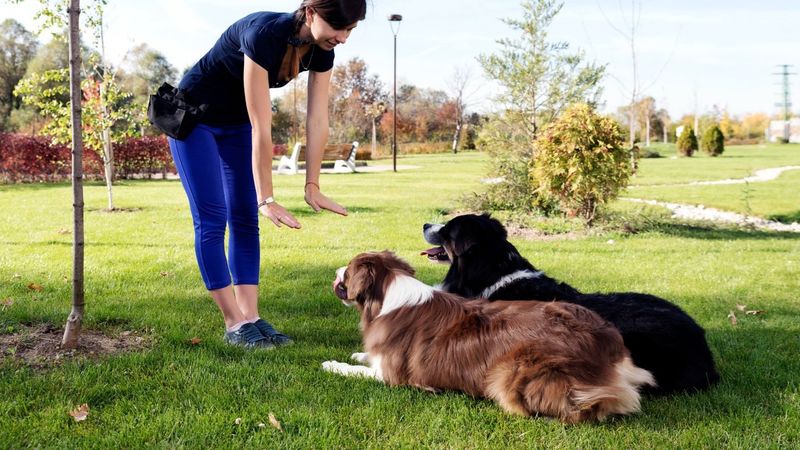What To Do About Your Neighbor’s Dog That Won’t Stop Barking

Living next to a neighbor with a barking dog can be quite the challenge, can’t it? You’re not alone, and thankfully, there are solutions!
Let’s explore some creative and friendly ways to address this common issue with your neighbor. Whether it’s building a bridge in communication or trying out soundproofing techniques, we have 12 unique pieces of advice to help restore peace and quiet to your life.
Dive in, and find the approach that fits your situation best!
1. Open A Friendly Dialogue

Sometimes, all it takes is a simple chat. Approach your neighbor with kindness and express your concerns about the barking.
They might not even be aware of the extent of the issue! Start by saying something like, “I know pets can be a handful!” This opens the door to a constructive conversation.
If possible, suggest solutions together. Maybe they have been searching for ways to calm their furry companion too.
By showing empathy, you build trust, leading to a collaborative solution. Your neighbor may appreciate your understanding, turning a potential conflict into cooperation.
2. Understanding The Cause

Why is the dog barking? Understanding the root cause can lead to a solution. Dogs bark for many reasons like boredom, anxiety, or even excitement.
Observe when the barking happens most. Is it when your neighbor leaves the house or during certain times of the day?
Share your observations with your neighbor in a gentle way. They might be surprised to learn these patterns.
Together, brainstorm ways to address these triggers, such as interactive toys or training. Solving the mystery of the barking could lead to a quieter neighborhood, one woof at a time!
3. Suggesting Professional Training

Professional help can work wonders. Suggest hiring a dog trainer to your neighbor. Trainers have the expertise to reduce excessive barking through positive reinforcement techniques.
You can even recommend local trainers known for their success.
Offering to attend a session with your neighbor shows your support and willingness to help. This shared effort could lead to great results, easing the noise and building a stronger sense of community.
Don’t underestimate the power of a well-trained dog – it’s like music to everyone’s ears!
4. Installing Soundproof Solutions

Sometimes, controlling the noise from your side is the best option. Soundproofing might be the practical solution you need. Consider adding heavy curtains or installing double-glazed windows to dampen the sound.
These additions not only reduce noise but enhance your home’s comfort and energy efficiency. Share these tips with your neighbor as well – they might find them useful!
Creating a quieter environment doesn’t have to be a solo project; it can be a shared journey toward a peaceful coexistence.
5. Offering To Walk The Dog

Could the dog need more exercise? Offer to take the dog for a walk. This simple gesture not only helps the dog burn off energy but can also reduce the barking from boredom.
It’s a win-win situation: the dog enjoys some attention, and you get some fresh air.
Plus, this act of kindness strengthens the neighborly bond. You might even discover that spending time with the dog creates a newfound connection.
Who knows? You could become the dog’s favorite walking buddy, making the neighborhood a happier place.
6. Exploring Anti-Bark Devices

Technology offers various solutions to barking problems. Anti-bark devices use sound or vibration to deter barking without causing harm.
Suggest these devices to your neighbor, explaining how they can be a humane way to address the issue. Some models even allow neighbors to work together on settings!
Remember to respect boundaries and present it as a potential solution, not an obligation. This tech-savvy approach might be just what the neighborhood needs for some peace and quiet.
7. Setting Up A Playdate

Socialization can do wonders for a barking dog. Suggest a playdate with your own pets if you have them, or organize one with other neighbors. Dogs often bark out of loneliness, and a little companionship can make a big difference.
This initiative not only helps reduce barking but also builds community spirit. You’ll create a network of pet-friendly neighbors who look out for each other.
It’s a delightful way to engage with your community and make new furry friends in the process.
8. Understanding Local Noise Ordinances

When all else fails, understanding your local noise ordinances can guide you. Researching the regulations gives you insights into your rights and responsibilities.
If the barking becomes unbearable, knowing these rules helps you take informed action.
It’s always advisable to resolve issues amicably first, but having this knowledge empowers you. Share what you learn with your neighbor – they might not be aware of the guidelines.
Together, you can work towards a peaceful solution, keeping legal actions as a last resort.
9. Create A Dog-Friendly Space

Encourage your neighbor to create a dog-friendly space in their yard. Areas with toys, obstacles, and a cozy resting spot can keep a dog entertained and reduce barking.
This dedicated space offers stimulation and comfort, aiding in minimizing noise. Collaborate on ideas for the setup, even contributing some toys or resources.
It’s a positive way to transform the dog’s behavior while enhancing its environment. Who wouldn’t want to see a joyous, less noisy pet?
10. Organizing A Community Pet Training Workshop

Bring the community together by organizing a pet training workshop. Invite a professional to guide the session, focusing on tackling common issues like excessive barking.
Such events foster community bonds and provide practical tips for pet owners. Your neighbor might appreciate the opportunity to learn alongside others facing similar challenges.
By pooling resources and knowledge, everyone benefits, and the neighborhood becomes a more harmonious place for both humans and pets.
11. Consider A Mediation Service

If talking isn’t getting anywhere, mediation could help. A neutral mediator can facilitate a discussion between you and your neighbor, focusing on resolving the barking issue.
This approach ensures both parties feel heard and understood. Mediation can lead to creative solutions that neither of you had considered.
Sometimes, an outside perspective is needed to see the problem from a different angle. With patience and open minds, you can reach a satisfactory agreement, restoring tranquility to your daily lives.
12. Using White Noise Machines

When all else fails, finding ways to manage the noise on your end might be necessary. White noise machines can mask barking sounds, creating a peaceful environment in your home.
These devices are particularly useful at night, ensuring you get a good night’s sleep. Mention this option to your neighbor as well, in case they face similar issues with other noises.
Embracing technology for personal comfort can be a simple yet effective solution.






